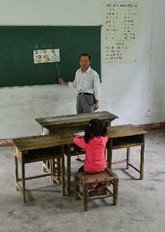Finding the best plan for every child
Like many teachers, for the two months of summer when I wasn’t receiving a paycheck, I worked odd jobs, waiting tables, bartending, running camps, teaching classes at a local university.
One of my favorite gigs was tutoring. Since I worked mostly with kids from nearby private schools, I was unfamiliar with their curriculum and methods. My understanding of my tutee’s needs was based solely on our interactions, and so I had to and was able to focus more on the learning side (the child) than the teaching side (me).
Working with children individually, you get to know them well enough to customize instruction. You both can ask any question and give each other immediate feedback. You don’t move on until you’re sure they’ve mastered what’s at hand. You also develop a better understanding of how they see your teaching and the material so you can modify those, too, in any way you think will be more effective.
The insights I gained from tutoring worked their way into my classroom. They changed conversations with colleagues about lesson design moving forward. We spent a lot of energy trying to see our students as individuals.
One size does not fit all.
 We don’t often have the luxury of being able to work with students one on one. Nor should we. Education is meant to be social and interactive. Students benefit as much from peer relationships and peer learning as from our direct instruction.
We don’t often have the luxury of being able to work with students one on one. Nor should we. Education is meant to be social and interactive. Students benefit as much from peer relationships and peer learning as from our direct instruction.
Teachers know that a didactic approach, treating a classroom of students as if one mass, is rarely effective for all. It’s like trying to jam square pegs into a board of round holes, or making a repair with whatever one material you have on hand (as in the picture at top!).
The educational sweet spot lies somewhere between the two extremes of passive/whole group/direct versus person-to-person/individualized instruction.
In my professional learning networks, whatever topic we may begin with, we often end up discussing that middle ground. We strive to strike the best balance between what is ideal, what is possible, what is fair, what is doable, and what is sustainable when it comes to delivering a more personalized experience in our classrooms.
We know we’ve succeeded not just when student grades rise. We know it when we see improvements in their engagement, enthusiasm, curiosity, and ability and willingness to expand their exploration and application beyond the current content. That’s when the student sees learning as personal.
Personalizing instruction is informed by a whole child mindset.
At its most rudimentary, education is the acquisition of knowledge and cognitive/intellectual growth. A whole child approach also considers their physical development, health, social-emotional needs, character, safety, sense of belonging/inclusion, and learning language and communication skills. (See ASCD’s recent whole child initiative.)
Every child will be at a different place regarding all these factors, so it’s impossible that any single lesson or approach can address every issue for every child. Fortunately, it doesn’t have to.
Personalized learning is rooted in constructivism, which posits that learners construct meaning and form new understandings largely influenced by their prior knowledge, beliefs, and experiences. That means we need to create an environment in which students can tap into their existing mindsets to make the most of new content. Every child has the power to learn powerfully, if we can only help them access it. (Ever watch kids play video games??)
As constructivist Paolo Friere said, “What the educator does in teaching is to make it possible for the students to become themselves.”
The potential role of technology to personalize learning
The value of technology to create more diverse learning experiences became tested during the pandemic. When it works, technology provides more flexibility and resources for students to individualize their education, like:
- On demand 24/7/365 access to course content and support
- Improved channels of communication
- The capacity for students to monitor their own progress using timely feedback
- Adaptive assessments (software that adjusts questions to an individual’s level of optimal challenge)
- Multisensory and multimedia approaches
- Nearly infinite access to information, data, and resources
- Availability of courses and content that might not otherwise be available, like learning the accordion, Russian, advanced computer programming, African history, or quantum physics.
Many digital tools– apps, games, YouTube, Khan Academy videos, online conferencing– help students learn at their own pace and in a variety of styles. Other tech tools– FlipGrid, TikToks, 2D and 3D digital design, animated slide decks, podcasts– can help them more effectively present their work to demonstrate understanding.
(Check out Sustainable Jersey for Schools’ new digital learning platform, with free guidelines and resources.)
Technology in itself won’t truly personalize learning, but it can support a personalized pedagogy when applied judiciously. Particularly after a year of remote learning, I will not be advocating for more screen time and students “left to their own devices”!
Let’s get personal.
This is more than a call for getting to know kids better. All students should find meaning and purpose in their learning. And major studies show that students whose teachers use personalized learning approaches make greater gains than students in more traditional settings (Herold, 2016).
The obvious premise is that not every student needs the same amount or kind of instruction on any given topic.
What personalized learning looks like in practice:
- Students are provided more choice and flexibility in
- ways and when to show evidence of mastery
- access to resources tailored to their needs
- learning modes, pacing, and quantity
- identifying and solving meaningful (authentic) problems
- Students become more self-directed, ideally through an active learning approach
- The teacher’s role shifts toward facilitator, coach, and mentor
- Schedules include flex time for independent study or “passion projects” (ex. genius hours)
- Spaces are customizable to meet student and lesson needs
- Diverse, relevant, rigorous, and relatable resources and tools are readily available via class libraries, kiosks, makerspaces, et al.
- School leaders nurture a student-focused culture in which nearly every conversation begins and ends with, “How does this help our students become successful lifelong learners?”

Teachers I have worked with would love to see this every day, for every child. But, practically speaking, they ask,
“How can I teach 25 different lessons simultaneously?”
Personalizing does not require writing a different customized lesson for each child. It’s about creating or modifying lessons to make them more flexible, open ended, and student directed.
Once the teacher has assured that students understand the material before moving on, each child is empowered to some degree to adapt the lesson to their needs. The focus is on growth, relative to the child’s current status, progress over time, and accepted core standards, rather than their standing relative to peers.
Strategies for personalizing learning:
- Identifying each student’s strengths, needs, and interests, and using that information to design lessons and choose resources
- More frequent checks for understanding, rather than grades
- Regular opportunities for student reflection, using journals, peer meetings, rubrics, checklists, turnkey teaching, and self assessments
- Structuring activities that emphasize teamwork and peer support
- Building in periodic one-on-one and small group conferencing time with the teacher
- Collecting and analyzing data to understand students as a whole as well as individuals
- Creating personalized learning plans to help students set goals, identify needed resources, plan a course of study, and agree upon evidence of success with their teachers.
Some will say personalized learning plans already exist, at least for our neediest children. Students with disabilities have IEPs. Non-classified students experiencing behavioral or academic problems have intervention, basic skills, or behavioral action plans.
These plans usually help the child keep up or catch up because they focus on deficits and remediation. They typically do not consider a student’s strengths, interests, aspirations, past experiences, culture, or personal goals. The child is usually not involved in the plan’s development, nor does every child have one.
A meaningful learning plan establishes high expectations, is flexible and evolving, and is co-created by each student.
Personalizing learning encourages educators to get to know as much as we can about each child, without always categorizing each data point as a strength or a weakness (sometimes it’s just a personal trait, still worthy of knowing).
The process helps remind us that each child has unique needs, wants, skills, dreams, and anxieties. When we view and treat them as individuals, we also move further from harmful practices like labeling, stereotyping, and tracking. Personalizing learning moves us ever closer to the American ideal of equal opportunity while providing the means and mindset to institutionalize equity in our schools.
⚙ Dr. Marc
COMING SOON: The Trifecta of Authentic, Active, and Personalized Learning
If you feel that someone in your professional network, neighborhood, the next classroom or cubicle would benefit from engaging in topics like the ones in these posts, I encourage you to forward them this email.
Recommended (free) resources for personalizing learning:
- Student Learning Plan template
- Primer on constructivism in the classroom, with activities, from Thirteen.org
- Personalized learning implementation framework from Education Elements
- Using data to personalize learning from the National Center for Education Statistics
- Review of empirical studies on PL from the Rand Corp
- A collection of apps for setting goals recommended by Julie Simpson at Hive (updated 12/23)
©2021 Marc Natanagara, Ed.D. All rights reserved. Reprinted with permission.
This article and other resources available at authenticlearningllc.com
When duplicating this post in any form, please include the attribution in italics above.
NOTE: In the push-and-pull between traditional grammar rules and social norms, equity and inclusivity win. Please note that I intentionally use “they, them, and theirs” in place of “she, hers, him, his” when referring to non-specific people or those whose identity choice I cannot ascertain.
Image of paved walkway from https://en.dopl3r.com/memes/dank/me-at-a-family-gathering/222729
Image of David Byrne in Stop Making Sense from http://blueprintreview.co.uk/2015/11/stop-making-sense/
Image of lone student in classroom from https://www.globaltimes.cn/ (original direct link disabled)
July 2021





